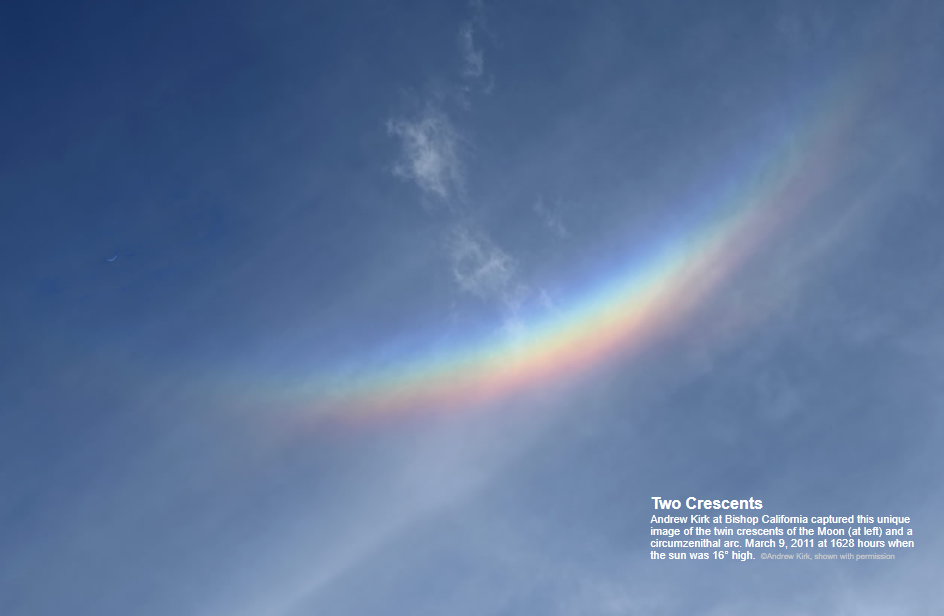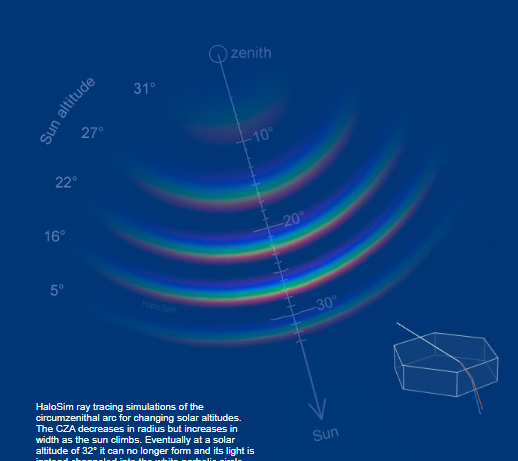OPOD - Two Crescents - Moon and Circumzenithal Arc
OPOD - Two Crescents: Moon and Circumzenithal Arc
Have you ever witnessed a celestial spectacle where two crescents adorn the sky, one belonging to the Moon and the other to a circumzenithal arc? This captivating phenomenon was beautifully captured by Andrew Kirk in Bishop, California, on March 9, 2011. The image showcases the twin crescents with the Moon on the left and the circumzenithal arc. Let's dive deeper into this enchanting atmospheric optics event and explore its intricacies.
The Fascinating Alignment
In this mesmerizing image, both crescents point in the same direction - towards the Sun. While the Moon, usually a dominant presence in the sky, appears dwarfed by the expansive ice-halo, the circumzenithal arc steals the spotlight with its vibrant colors. This celestial phenomenon is a result of sunlight refracted through the equivalent of a 90° ice prism.
Understanding the Circumzenithal Arc
The width of the circumzenithal arc can be estimated to be approximately 3° based on the Moon's known 0.5° diameter. This broad dispersion of colors arises from sunlight entering the top faces of horizontally aligned hexagonal plate crystals and exiting through vertical side faces. This process creates one of the most beautiful halos observed in the sky.
As the Sun climbs higher in the sky, the circumzenithal arc undergoes changes in its appearance. HaloSim ray tracing simulations demonstrate that the arc decreases in radius but increases in width. However, when the solar altitude reaches 32°, it can no longer form, and its light is redirected into the white parhelic circle.
The Dance of Light and Altitude
The behavior of the circumzenithal arc is intricately linked to the altitude of the Sun. When the Sun sinks below the critical altitude of 32°, the arc initially appears as a broad smudge near the zenith. As the Sun's altitude decreases further, the arc transforms into the familiar crescent shape and moves away from the zenith. The brightest display of the circumzenithal arc occurs when the Sun is around 20° high, while it becomes fainter as the Sun approaches the horizon.
Capturing the Beauty
If you wish to capture the ethereal beauty of halos through photography, still cameras are your best companion. They enable you to capture subtle details and even uncover rare arcs that might otherwise go unnoticed. On the other hand, video cameras may not be as halo-friendly due to their limitations in capturing the intricacies of these atmospheric phenomena.
Conclusion
The convergence of the Moon's crescent and the circumzenithal arc in the sky creates a truly enchanting sight. Understanding the science behind this phenomenon adds a layer of appreciation for the beauty of atmospheric optics. The interplay of sunlight, ice crystals, and the angle of the Sun all contribute to the formation and appearance of this celestial display. So, keep your eyes peeled for the next opportunity to witness this captivating event and be prepared to capture its ephemeral beauty with your camera.

Two Crescents
Andrew Kirk at Bishop California captured this unique image of the twin crescents of the Moon (at left) and a circumzenithal arc. March 9, 2011 at 1628 hours when the sun was 16° high. ©Andrew Kirk, shown with permission

HaloSim ray tracing simulations of the circumzenithal arc for changing solar altitudes. The CZA decreases in radius but increases in width as the sun climbs. Eventually at a solar altitude of 32° it can no longer form and its light is instead channeled into the white parhelic circle.
Both crescents point in the same direction � sunwards.
The Moon, usually a dominant sky object, is dwarfed by the ice-halo.
From the Moon�s known 0.5� diameter we can estimate the width of the circumzenithal arc as about 3�. This broad dispersion of colours arises because it is formed by sunlight refracted through the equivalent of a 90� ice prism.
Light enters the top faces of horizontally aligned hexagonal plate crystals and leaves through a vertical side faces to form the most beautiful of all the halos.
Rays entering along this route when the sun is higher than 32� cannot leave a side face but are instead totally internally reflected to eventually contribute to the parhelic circle.
As the sun sinks below the 32� critical altitude the CZA first forms as a broad smudge close to the zenith. At lower sun altitudes it transforms into the familiar crescent. It moves further from the zenith with decreasing sun altitude.
It is at its brightest when the sun is around 20� high and becomes very faint when the sun is close to the horizon.
Photographing halos? - Still cameras are best for capturing both subtle details and any unnoticed rare arcs that might be present. Video cameras are not very halo friendly!
Note: this article has been automatically converted from the old site and may not appear as intended. You can find the original article here.
Reference Atmospheric Optics
If you use any of the definitions, information, or data presented on Atmospheric Optics, please copy the link or reference below to properly credit us as the reference source. Thank you!
-
<a href="https://atoptics.co.uk/blog/opod-two-crescents-moon-and-circumzenithal-arc/">OPOD - Two Crescents - Moon and Circumzenithal Arc</a>
-
"OPOD - Two Crescents - Moon and Circumzenithal Arc". Atmospheric Optics. Accessed on July 27, 2024. https://atoptics.co.uk/blog/opod-two-crescents-moon-and-circumzenithal-arc/.
-
"OPOD - Two Crescents - Moon and Circumzenithal Arc". Atmospheric Optics, https://atoptics.co.uk/blog/opod-two-crescents-moon-and-circumzenithal-arc/. Accessed 27 July, 2024
-
OPOD - Two Crescents - Moon and Circumzenithal Arc. Atmospheric Optics. Retrieved from https://atoptics.co.uk/blog/opod-two-crescents-moon-and-circumzenithal-arc/.